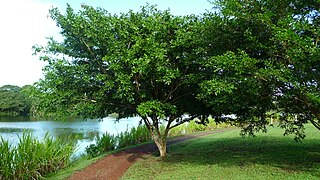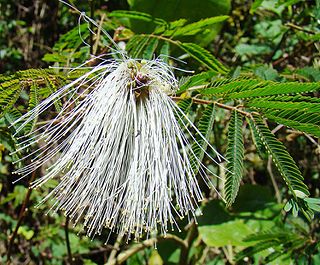
The Mimosoideae are a traditional subfamily of trees, herbs, lianas, and shrubs in the pea family (Fabaceae) that mostly grow in tropical and subtropical climates. They are typically characterized by having radially symmetric flowers, with petals that are twice divided (valvate) in bud and with numerous showy, prominent stamens.

Abarema is a neotropical genus in the family Fabaceae. It is native to Brazil, Cuba, and Venezuela. Most of the species can be found in the Amazon Basin and the Guyana Highlands. They have a deep-green fernlike foliage, with bipinnately compound leaves.

Abarema centiflora is a species of plant in the family Fabaceae. It is endemic to the east slope of the Bolivian Andes. It is a small tree found in humid montane forests.

Chloroleucon is a genus of flowering plants in the family Fabaceae. It contains 11 species native to the tropical Americas, ranging from Mexico through Central America, the Caribbean, and South America to northern Argentina. Some authorities consider it part of the genus Albizia. Its name is derived from the Greek words χλωρóς (chloros), meaning "green," and λευκός (leukos), meaning "white."

Cojoba is a genus of flowering plants in the family Fabaceae. There are 37 described species, of which 20 are accepted This genus can be found in South America.
Hydrochorea is a genus of flowering plants in the family Fabaceae. It includes 11 species native to Central and South America and west and west-central Africa. It belongs to the mimosoid clade of the subfamily Caesalpinioideae.

Macrosamanea is a genus of flowering plant in the legume family, Fabaceae. It includes 11 species of trees and shrubs native to northern South America. The genus is most diverse and numerous in the Amazon Basin, extending into the Orinoco basin and the Guianas. Typical habitat is tropical rain forest, mostly riparian and seasonally-flooded. Two species are native to seasonally-inundated wooded grassland (savanna) on sandy soils. The genus belongs to the mimosoid clade of the subfamily Caesalpinioideae.

Pithecellobium is a genus of flowering plants in the family Fabaceae. It includes approximately 23 species from the tropical Americas, ranging from Mexico to Peru and northern Brazil, including the Caribbean Islands and Florida.

Zygia is a genus of flowering plants in the family Fabaceae. It belongs to the mimosoid clade of the subfamily Caesalpinioideae.
Pseudosamanea is a genus of flowering plant in the family Fabaceae, native from southern Mexico to Venezuela and Ecuador, and to Cuba. The genus was established in 1930.

Ebenopsis is a genus of flowering plants in the family Fabaceae. It includes three species native to Mexico and Texas.
Hesperalbizia is a genus of flowering plants in the family Fabaceae. It belongs to the mimosoid clade of the subfamily Caesalpinioideae. The only species is Hesperalbizia occidentalis. It is native to Mexico and is known by the common name palo escopeta.
Pityrocarpa is a genus of flowering plants in the family Fabaceae. It includes seven species of shrubs and small trees native to the tropical Americas, including western and southeastern Mexico, Guatemala and El Salvador, Venezuela and Guyana, Bolivia, and eastern Brazil. Native habitats include tropical coastal rain forest, gallery forest, secondary forest, woodland, wooded grassland (Cerrado), and thorn scrub (Caatinga). It belongs to the mimosoid clade of the subfamily Caesalpinioideae.
Abarema floribunda is a species of plant of the genus Abarema in the family Fabaceae.
Abarema levelii is a species of plant of the genus Abarema in the family Fabaceae. It is native to Venezuela and north Brazil.

Jupunba is a genus in the family Fabaceae. It is native to region from South Mexico extending to tropical America.
Pseudalbizzia is a genus of flowering plants in the pea family (Fabaceae). It includes 17 species which are native to the tropical Americas, from Mexico to northern Argentina.

Hydrochorea elegans is a species of flowering plants in the family Fabaceae. It is a tree in the emergent layer of the tropical rainforest of southern Central America and northern South America. The species was formerly known as Balizia elegans, and reassigned to genus Hydrochorea in 2022.
James Walter Grimes, known as Jim Grimes, is an American botanist.











